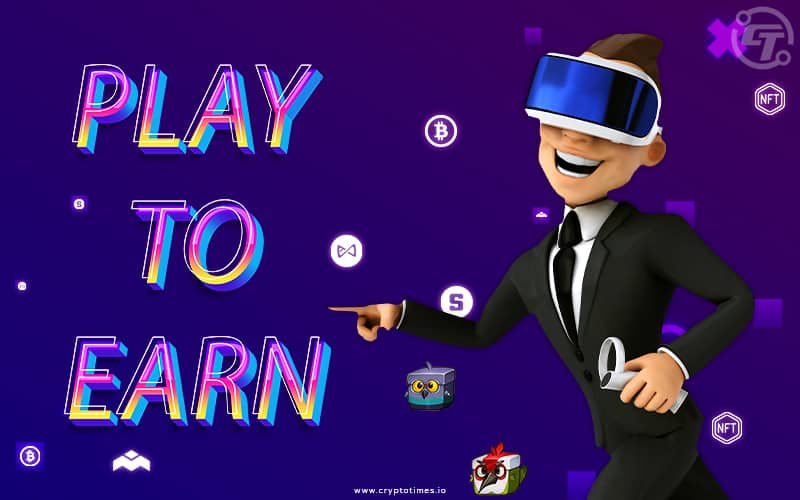Play-to-earn games came as a big break for the gaming industry. In the last few months, game developers and gamers have witnessed significant growth in the gaming sector. In fact, 2021 has been a ‘game changer’ both literally and metaphorically, with NFTs and cryptocurrencies beginning to take root in the gaming economy.
The decentralized nature of crypto assets, its propensity to always be on-trend, and the inevitable popularity that came with it, means that – adopting crypto or NFTs as rewards in games, was no brainer for game developers.
To turn the idea into reality, the unique gameplay model pieced together a variety of digital assets in one frame, resulting in what we now refer to as Play-To-Earn NFT games.
Play-To-Earn Concept
Play-To-Earn is a decentralized approach to transforming the traditional gaming experience. The fundamental purpose to leverage blockchain technology in gaming is to establish a user-driven gaming economy. Simply put, the Play-To-Earn crypto gaming model, as the term suggests, allows gamers to earn rewards for playing games. These rewards are in the form of crypto assets like Bitcoin, NFTs, etc.
The concept of Play-To-Earn games is based on empowering gamers monetarily while making the gameplay interesting with exciting crypto rewards. It encourages the players to create, buy and sell in-game items as NFTs across several marketplaces, thus generating a steady stream of income for them. Apart from selling and collecting in-game items as NFTs, there are multiple alternatives to utilize the Play-To-Earn gaming model which we will discuss later in this article.
The gaming industry has realized the potential of the Play-To-Earn gaming model in numerous ways through which one can earn in exchange for playing the game. This ensures that gamers’ time and efforts are put to good use, in turn serving the players in extracting passive income. Thus, players can then sell the in-game content that they get as a reward for better returns.
Different ways to get paid via Play-To-Earn Games:
Play-To-Earn crypto-based games focus on incentivizing gamers for playing games that they otherwise would play for enjoyment with no earnings. In the crypto space, there are three ways to draw an income via the Play-To-Earn gaming model –
- Buying, selling, and earning in-game collectibles as NFTs
- Earning in-game cryptocurrency rewards
- Staking
This gaming concept progressed so quickly that some players began to consider it their primary source of income. Well, to know why and how Play-To-Earn games have turned into a gig for gaming enthusiasts. Let’s discuss perks, processes, and prerequisites to earn from Play-To-Earn games.
1. Buying, Selling, and Earning in-game collectibles as NFTs:
To begin with, we have several techniques to explore Play-To-Earn games. In this new realm of gaming, there are two kinds of play-to-earn games. One that requires investing some amount to get started and the other which offers free gameplay.
The games that have reached a certain level of popularity often require gamers to pay a certain amount to buy characters in order to start playing. Professional gamers are more into such games as these games offer heavy rewards.
Players who are new to the decentralized gaming world have a tendency to opt for free play-to-earn games. The reason is simple: It’s not always feasible for all players to start a game with such a high amount to get a kick start. Also, it becomes intimidating for the players who are just starting with the new Play-To-Earn concept. Nevertheless, both types give players a chance to trade created or purchased in-game items as NFTs.
The most popular Play-To-Earn game and also the one that offers quite expensive gameplay is Axie Infinity. NFT games that have zero to negligible cost for players to start from scratch are Gods Unchained, Splinterlands, Chainmonsters, and The Sandbox, etc.
To get started, there are three ways to start earning via playing NFT-based Play-To-Earn Games-
- Players can purchase NFTs of particular characters from the app store in order to sell them later on the gaming platform or a secondary market, or
- Players also get NFTs as rewards when they hit a milestone in the game or complete certain levels. These NFTs can be traded to generate income.
- They can develop their own characters or unlock avatars by performing certain actions and winning various levels in the game. The characters obtained can then be traded as NFTs.
In traditional video games, these avatars or characters are mere fun elements that make the gameplay interesting. Through Play-to-Earn games. Gamers can create, buy and sell the NFTs which can be characters, tools, weapons, skins, and accessories. Apart from trading these NFTs with other players in the game universe, they can also sell these collectibles on various secondary marketplaces like OpenSea and Nifty Gateway.
2. Earning In-Game Cryptocurrency rewards
NFT rewarding and NFT based games are trending in the gaming industry. Even crypto-based Play-To-Earn games are on their way to being the next big thing. In this, players can perform certain tasks to complete stages in the game to win crypto rewards.
These rewards are either in the form of a gaming platform’s native token or in some other cryptocurrency such as Bitcoin. Generally, gaming platforms offer native token rewards which players can cash out as per their preferred crypto or fiat currency.
One such example is Axie Infinity’s Smooth Love Potion (SLP) which can be obtained by performing daily missions or fighting players and monsters. The crypto prizes are determined by the player’s position on the leaderboard. The higher you climb the leaderboard, the more awards you’ll receive.
3. Staking
Staking is the most incentivizing method to earn rewards. Take the example of MBOX in which players are offered crypto rewards for participating in the various games provided by the platform.
These Play-To-Earn games range from NFT farming to yield farming and blockchain gaming. In this, gamers can stake in liquidity pools or trade MOMO NFTs (the platform’s NFTs) to earn staking rewards. These rewards are paid in the native MBOX currency.
Furthermore, staking MBOX tokens can reward unique MOMO NFT Mystery Boxes. Each box consists of a random NFT of different rarities. This creates an extra incentive for players to hold and exchange the platform’s native token to generate passive income. But note that users will need a very large initial deposit to earn large staking rewards.
Play-To-Earn Mechanism – Axie Infinity Gameplay
Gaming hasn’t been perceived as monetarily rewarding activity for average players. For regular gamers, it becomes challenging to utilize play-to-earn games to make an income. However, many players come from developing countries who started to earn living wages from crypto games such as Axie Infinity. If the Play-To-Earn trend continues, it may become popular, with more individuals engaging from all over the world.
Though each Play-To-Earn has its unique gameplay, to understand how this gaming model works, Let’s take Axie Infinity as an example:
Axie Infinity has emerged as the most prominent platform to introduce the play-to-earn model. It allows users to create a collection of “Axies” which they can trade across the company’s game universe. The company then uses blockchain to reward its players for participating. Besides, players can also trade on platforms outside the game’s universe. This is possible because any in-game goods a player owns or breeds are considered his or her property which can be sold as and when needed.
There are many perks that come with Play-To-Earn games. One of them is – Gamers can sell Axies in an effort to get their money back if they anytime decide to stop playing the game.
As discussed above, not all Play-To-Earn games are ‘free’ – Axie Infinity is one of them. To start playing this game, players need to invest in three Axies (platform’s in-game NFT characters), with each Axie worth from hundred to thousands of dollars as per their rarity and attributes.
Once you own Axies, you can start making a profit by selling SLPs (smooth love potions), breeding rare Axies, and through the platform’s native token AXS staking. Players can even earn crypto in exchange for playing various games that the platform offers.
In addition, each Axie in itself is a non-fungible token (NFT), that is minted on the Ethereum blockchain. That’s the reason why Axies cost money, and selling them generates profit.
Play-to-Earn NFT games have gotten a lot of attention because of their low entrance cost and the enormity of the rewards later on. Axie Infinity went a step further in that too and incorporated crypto rewards as well. Players can also receive rewards for completing daily quests and missions in the form of AXS tokens. The bottom line is, Play-To-Earn games have integrated NFTs as well as crypto rewards-based gameplay, leaving no stone unturned in the decentralized space.
Ways to Cash-Out earnings
Play-To-Earn games are revolutionizing the gameplay with attractive rewards for players. As discussed above, these rewards are in the form of crypto and NFTs. To utilize the rewards earned, it is necessary to convert them into some mainstream currency or cryptocurrency.
1. Cashing out crypto rewards
Gaming platform’s tokens won’t buy you anything other than more in-game items, you can only stake tokens to earn more rewards. Yet, at the end of the day, one needs to cash out the tokens to actually benefit from Play-To-Earn games financially.
To cash out a token, for example, Axie Infinity’s AXS token, players will need an exchange that provides play-to-earn crypto in a tradeable pair. To make use of earned rewards and tokens in real life, gamers should keep in mind whether they can exchange the tokens for fiat currency (such as USD and Euros) and transfer them to their bank account.
The other way to cash out is to use a crypto card to spend the crypto-rewards. Crypto cards are similar to casual debit cards, but that doesn’t mean you can perform all the transactions in digital currency.
Crypto cards act as an intermediary that first takes the cryptocurrency from your linked account. Then, it converts the crypto into the local currency and ultimately allows the users the cash to pay. One can also convert their earnings into a stablecoin, but this requires an extra step in order to cash out.
2. Cashing out in-game NFTs
Game developers have leveraged NFTs in the gameplay making it more exciting. A new and fascinating era in the gaming industry ushers in blockchain and NFTs amalgamation. The NFT rewards and collectibles turned out to be in favor of gamers.
Anything that offers an opportunity to earn money can never go downhill in the market. Gaining rewards is not enough when it can not be turned into cold hard cash which you can spend. To do that, players need to trade their earned NFTs through NFT exchanges.
The NFT marketplaces offer a deposit feature and allow to sell the NFTs directly on the platform, one such NFT marketplace example is – Binance. There are other NFT marketplaces too that allow players to buy and sell NFTs such as OpenSea and Nifty Gateway.
Security Benefits and concerns
Play-To-Earn games surely are a new avenue for both gamers and game developers. There is a reason why people are inclined towards this gaming model. Let’s understand how blockchain-backed play-to-earn games can take over regular games.
The Play-To-Earn gaming model offers not only rewards but also a number of security benefits that we have mentioned below:
1. Improved privacy and security
Games based on a centralized server are hackable, a player can anytime lose data or their personal details can be misused. While in blockchain-based decentralized servers it is near impossible due to highly encrypted cryptography.
2. Decentralized structure builds trust
For this gaming concept to be embraced widely, there must be trust among gamers and game developers. A decentralized structure enables sharing of data within the ecosystem where no single entity is exclusively in charge of the gaming economy.
Since no one is in charge of facilitating the transactions made or information shared, blockchain provides end-to-end encryption. Therefore unauthorized activity and fraud can not take place, which eventually builds trust in the decentralized gaming system.
3. Individual control over assets earned
In an era where data is a very valuable entity, it becomes vital to protect the stored information while allowing the user to control and access it anytime. Similarly, when a player completes a game, most of their in-game collections are either destroyed or become inaccessible in the traditional gaming system. Using blockchain, gamers can decide on what in-game items they want to exchange or share with whom and for how long. Additionally, players have ownership of their in-game items till eternity with the freedom to trade as and when required.
4. Immutability
Blockchain preserves the rarity of certain in-game items as they cannot be copied due to the ledger system. Further, all transactions are date and time-stamped with a permanent record. This system allows tracking information for maintaining a secure and reliable gaming model. In simple words, once recorded all the in-game digital assets can’t be deleted or changed.
Now, why would gamers trust these blockchain-based games instead of their regular ones?
- Games based on a centralized server are hackable, a player can anytime lose data or their personal details can be misused. While in blockchain based decentralised servers it is near impossible due to highly encrypted cryptography.
- Enhance Ownership of assets, once a player completes a game most of their in-game collection are either destroyed or becomes inaccessible but using blockchain they have ownership of their items till eternity.
- Blockchain preserves the rarity of certain in-game items as they cannot be copied due to the ledger system.
The Final Word:
Play-To-Earn games have evolved into something that now everybody in the crypto space wants to adopt and utilize. Many new projects are incubating with the increasing demand from gamers around the world. Not to deny, this gaming model is prone to risks associated with scams and frauds in the decentralized space.
Yet, this has opened a new stream of income for gamers and game developers. Consequently, promoted an open gaming economy where everybody can participate and earn via playing games which otherwise was just a fun time activity. The escalating profitability is attracting more and more players to explore the Play-To-Earn Games.
Also Read : The Year When NFT Craze Went Wild: 2021 Wrap Up







